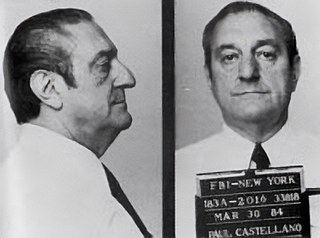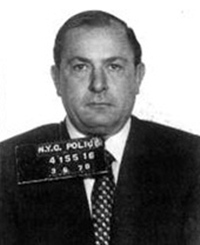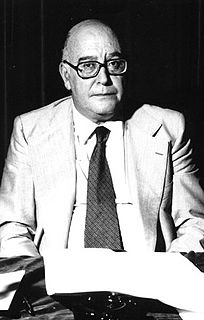The Castellammarese War was a bloody power struggle for control of the Italian-American Mafia, from February, 1930 to April 15, 1931, between partisans of Joe "The Boss" Masseria and those of Salvatore Maranzano. It was so called because Maranzano was based in Castellammare del Golfo, Sicily. Maranzano's faction won, and he declared himself capo di tutti capi, the undisputed leader of the entire Mafia. However, he was soon murdered in turn by a faction of young upstarts led by Lucky Luciano, who established a power-sharing arrangement called "The Commission," a group of five Mafia families of equal stature, to avoid such wars in the future.
The Bufalino crime family, also known as the Pittston crime family, Scranton Wilkes-Barre family, Northeastern Pennsylvania crime family, Northeastern Pennsylvania Mafia, or Scranton Mafia is an Italian-American Mafia crime family active in the Northeastern Pennsylvania cities of Scranton, Wilkes-Barre, and Pittston.
Consigliere is a position within the leadership structure of the Sicilian, Calabrian and American Mafia. The word was popularized by the novel The Godfather (1969) and its film adaptation. In the novel, a consigliere is an advisor or counselor to the boss, with the additional responsibility of representing the boss in important meetings both within the boss's crime family and with other crime families. The consigliere is a close, trusted friend and confidant, the mob's version of an elder statesman; he is an advisor to the boss in a Mafia crime family, and sometimes is his 'right-hand man'. By the very nature of the job, a consigliere is one of the few in the family who can argue with the boss, and is often tasked with challenging the boss when needed, to ensure subsequent plans are foolproof. In some depictions, he is devoid of ambition and dispenses disinterested advice. This passive image of the consigliere does not correspond with what little is known of real-life consiglieri, however.
The Corleone family is a fictional Sicilian-American organized crime family, and the focus of the novels and films of The Godfather series. The family was created by Mario Puzo and first appears in his 1969 novel The Godfather. The family is from Corleone, Sicily, Italy and is based in New York City.

The Mafia Commission Trial, officially known as United States v. Anthony Salerno, et al., was a criminal trial in New York City, United States. Using evidence obtained by the Federal Bureau of Investigation, eleven organized crime figures, including the heads of New York's so-called "Five Families," were indicted by United States Attorney Rudolph Giuliani under the Racketeer Influenced and Corrupt Organizations Act (RICO) on charges including extortion, labor racketeering, and murder for hire. The case struck a blow against "The Commission," a loose organization of the New York Mafia organizations that met to resolve disputes or discuss criminal activities, sometimes likened to organized crime's board of directors. Time magazine called this "Case of Cases" possibly "the most significant assault on the infrastructure of organized crime since the high command of the Chicago Mafia was swept away in 1943," and quoted Giuliani's stated intention: "Our approach... is to wipe out the five families."

The Five Families are the five major New York City organized crime families of the Italian American Mafia.

The Colombo crime family is the youngest of the "Five Families" that dominates organized crime activities in New York City, United States, within the nationwide criminal organization known as the Mafia. It was during Lucky Luciano's organization of the American Mafia after the Castellammarese War, and the assassinations of Giuseppe "Joe The Boss" Masseria and Salvatore Maranzano, that the gang run by Joseph Profaci was recognized as the Profaci crime family.

A caporegime or capodecina, usually shortened to just a capo, is a rank used in the Mafia for a made member of the crime family who heads a "crew" of soldiers and has major social status and influence in the organization. Caporegime is an Italian word, which is used to signify the head of a family in Sicily, but has now come to mean a ranking member, similar to captain or senior sergeant in a military unit. In general, the term indicates the head of a branch of an organized crime syndicate who commands a crew of soldiers and reports directly to the Don (Boss) or an Underboss or Streetboss.
In the American Mafia and Sicilian Mafia, a made man is a fully initiated member of the Mafia. To become "made," an associate first has to be sponsored by another made man. An inductee will be required to take the oath of Omertà, the mafia code of silence. After the induction ceremony, the associate becomes a "made man" and holds the rank of soldier in the Mafia hierarchy.

Underboss is a position within the leadership structure of Sicilian, Greek, and American Mafia crime families. The underboss is second in command to the boss. The underboss is sometimes a family member, such as a son, who will take over the family if the boss is sick, killed, or imprisoned. However the position of street boss has somewhat challenged the rank of underboss in the modern era. The position was installed within the Genovese crime family since at least the mid 1960s. It has also been used in the Detroit crime family and the Chicago Outfit.
Peter Magaddino was a mobster in the Magaddino crime family of Buffalo, New York. The son of crime boss Stefano "The Undertaker" Magaddino, Magaddino was a caporegime in the family and possibly an underboss.
The 116th Street crew, also known as the Uptown crew, is a powerful crew within the Genovese crime family. In the early 1960s, Anthony Salerno became one of the most powerful capos in the family. Salerno based the crew out of the Palma Boys Social Club located 416 East 115th Street in East Harlem, Manhattan. By the late 1970s and early 1980s, the 116th Street crew had absorbed and initiated many former members of the vicious East Harlem Purple Gang, an Italian-American murder for hire and drug trafficking gang operating in 1970s Italian Harlem and acting generally independent of the Mafia.

Michael "Mimi" Sabella (1911–1989) was a caporegime in the Bonanno crime family and a relative of Philadelphia crime family mob boss Salvatore Sabella.
Nicholas Angelo "Nicky Mouth" Santora is the reputed underboss of the Bonanno crime family.

A soldato is the first official level of both the American Mafia and the Sicilian Mafia in the formal Mafia hierarchy or cadre. The promotion to the rank of soldier is an elevation in the chain of command from the associate level. The associate must prove himself to the family and take the oath of Omertà. Picciotto is often used to refer to a lower-level mafioso or soldato, but it usually indicates a younger, inexperienced soldato and may even be used to refer to a closely connected, up-and-coming associate who is not necessarily a made man yet. "Picciotti" usually perform simple tasks such as beatings and robbery.
This is a glossary of words related to the Mafia, primarily the Italian American Mafia and Sicilian Mafia.
{{#if:{{{1}}}|{{#tag:li|{{{1}}}|style="{{{style|}}}"|id="alist{{{name}}}{{1x|-}}{{{i}}}"}}}}{{#if:{{{1}}}|{{#tag:li|{{{1}}}|style="{{{style|}}}"|id="alist{{{name}}}{{1x|-}}{{{i}}}"}}}}{{#if:{{{1}}}|{{#tag:li|{{{1}}}|style="{{{style|}}}"|id="alist{{{name}}}{{1x|-}}{{{i}}}"}}}}{{#if:{{{1}}}|{{#tag:li|{{{1}}}|style="{{{style|}}}"|id="alist{{{name}}}{{1x|-}}{{{i}}}"}}}}{{#if:{{{1}}}|{{#tag:li|{{{1}}}|style="{{{style|}}}"|id="alist{{{name}}}{{1x|-}}{{{i}}}"}}}}{{#if:{{{1}}}|{{#tag:li|{{{1}}}|style="{{{style|}}}"|id="alist{{{name}}}{{1x|-}}{{{i}}}"}}}}{{#if:{{{1}}}|{{#tag:li|{{{1}}}|style="{{{style|}}}"|id="alist{{{name}}}{{1x|-}}{{{i}}}"}}}}{{#if:{{{1}}}|{{#tag:li|{{{1}}}|style="{{{style|}}}"|id="alist{{{name}}}{{1x|-}}{{{i}}}"}}}}{{#if:{{{1}}}|{{#tag:li|{{{1}}}|style="{{{style|}}}"|id="alist{{{name}}}{{1x|-}}{{{i}}}"}}}}{{#if:{{{1}}}|{{#tag:li|{{{1}}}|style="{{{style|}}}"|id="alist{{{name}}}{{1x|-}}{{{i}}}"}}}}{{#if:{{{1}}}|{{#tag:li|{{{1}}}|style="{{{style|}}}"|id="alist{{{name}}}{{1x|-}}{{{i}}}"}}}}{{#if:{{{1}}}|{{#tag:li|{{{1}}}|style="{{{style|}}}"|id="alist{{{name}}}{{1x|-}}{{{i}}}"}}}}{{#if:{{{1}}}|{{#tag:li|{{{1}}}|style="{{{style|}}}"|id="alist{{{name}}}{{1x|-}}{{{i}}}"}}}}{{#if:{{{1}}}|{{#tag:li|{{{1}}}|style="{{{style|}}}"|id="alist{{{name}}}{{1x|-}}{{{i}}}"}}}}{{#if:{{{1}}}|{{#tag:li|{{{1}}}|style="{{{style|}}}"|id="alist{{{name}}}{{1x|-}}{{{i}}}"}}}}{{#if:{{{1}}}|{{#tag:li|{{{1}}}|style="{{{style|}}}"|id="alist{{{name}}}{{1x|-}}{{{i}}}"}}}}{{#if:{{{1}}}|{{#tag:li|{{{1}}}|style="{{{style|}}}"|id="alist{{{name}}}{{1x|-}}{{{i}}}"}}}}{{#if:{{{1}}}|{{#tag:li|{{{1}}}|style="{{{style|}}}"|id="alist{{{name}}}{{1x|-}}{{{i}}}"}}}}{{#if:{{{1}}}|{{#tag:li|{{{1}}}|style="{{{style|}}}"|id="alist{{{name}}}{{1x|-}}{{{i}}}"}}}}{{#if:{{{1}}}|{{#tag:li|{{{1}}}|style="{{{style|}}}"|id="alist{{{name}}}{{1x|-}}{{{i}}}"}}}}{{#if:{{{1}}}|{{#tag:li|{{{1}}}|style="{{{style|}}}"|id="alist{{{name}}}{{1x|-}}{{{i}}}"}}}}{{#if:{{{1}}}|{{#tag:li|{{{1}}}|style="{{{style|}}}"|id="alist{{{name}}}{{1x|-}}{{{i}}}"}}}}{{#if:{{{1}}}|{{#tag:li|{{{1}}}|style="{{{style|}}}"|id="alist{{{name}}}{{1x|-}}{{{i}}}"}}}}{{#if:{{{1}}}|{{#tag:li|{{{1}}}|style="{{{style|}}}"|id="alist{{{name}}}{{1x|-}}{{{i}}}"}}}}{{#if:{{{1}}}|{{#tag:li|{{{1}}}|style="{{{style|}}}"|id="alist{{{name}}}{{1x|-}}{{{i}}}"}}}}{{#if:{{{1}}}|{{#tag:li|{{{1}}}|style="{{{style|}}}"|id="alist{{{name}}}{{1x|-}}{{{i}}}"}}}}{{#if:{{{1}}}|{{#tag:li|{{{1}}}|style="{{{style|}}}"|id="alist{{{name}}}{{1x|-}}{{{i}}}"}}}}{{#if:{{{1}}}|{{#tag:li|{{{1}}}|style="{{{style|}}}"|id="alist{{{name}}}{{1x|-}}{{{i}}}"}}}}{{#if:{{{1}}}|{{#tag:li|{{{1}}}|style="{{{style|}}}"|id="alist{{{name}}}{{1x|-}}{{{i}}}"}}}}{{#if:{{{1}}}|{{#tag:li|{{{1}}}|style="{{{style|}}}"|id="alist{{{name}}}{{1x|-}}{{{i}}}"}}}}{{#if:{{{1}}}|{{#tag:li|{{{1}}}|style="{{{style|}}}"|id="alist{{{name}}}{{1x|-}}{{{i}}}"}}}}{{#if:{{{1}}}|{{#tag:li|{{{1}}}|style="{{{style|}}}"|id="alist{{{name}}}{{1x|-}}{{{i}}}"}}}}{{#if:{{{1}}}|{{#tag:li|{{{1}}}|style="{{{style|}}}"|id="alist{{{name}}}{{1x|-}}{{{i}}}"}}}}{{#if:{{{1}}}|{{#tag:li|{{{1}}}|style="{{{style|}}}"|id="alist{{{name}}}{{1x|-}}{{{i}}}"}}}}{{#if:{{{1}}}|{{#tag:li|{{{1}}}|style="{{{style|}}}"|id="alist{{{name}}}{{1x|-}}{{{i}}}"}}}}{{#if:{{{1}}}|{{#tag:li|{{{1}}}|style="{{{style|}}}"|id="alist{{{name}}}{{1x|-}}{{{i}}}"}}}}{{#if:{{{1}}}|{{#tag:li|{{{1}}}|style="{{{style|}}}"|id="alist{{{name}}}{{1x|-}}{{{i}}}"}}}}{{#if:{{{1}}}|{{#tag:li|{{{1}}}|style="{{{style|}}}"|id="alist{{{name}}}{{1x|-}}{{{i}}}"}}}}{{#if:{{{1}}}|{{#tag:li|{{{1}}}|style="{{{style|}}}"|id="alist{{{name}}}{{1x|-}}{{{i}}}"}}}}{{#if:{{{1}}}|{{#tag:li|{{{1}}}|style="{{{style|}}}"|id="alist{{{name}}}{{1x|-}}{{{i}}}"}}}}{{#if:{{{1}}}|{{#tag:li|{{{1}}}|style="{{{style|}}}"|id="alist{{{name}}}{{1x|-}}{{{i}}}"}}}}{{#if:{{{1}}}|{{#tag:li|{{{1}}}|style="{{{style|}}}"|id="alist{{{name}}}{{1x|-}}{{{i}}}"}}}}{{#if:{{{1}}}|{{#tag:li|{{{1}}}|style="{{{style|}}}"|id="alist{{{name}}}{{1x|-}}{{{i}}}"}}}}{{#if:{{{1}}}|{{#tag:li|{{{1}}}|style="{{{style|}}}"|id="alist{{{name}}}{{1x|-}}{{{i}}}"}}}}{{#if:{{{1}}}|{{#tag:li|{{{1}}}|style="{{{style|}}}"|id="alist{{{name}}}{{1x|-}}{{{i}}}"}}}}{{#if:{{{1}}}|{{#tag:li|{{{1}}}|style="{{{style|}}}"|id="alist{{{name}}}{{1x|-}}{{{i}}}"}}}}{{#if:{{{1}}}|{{#tag:li|{{{1}}}|style="{{{style|}}}"|id="alist{{{name}}}{{1x|-}}{{{i}}}"}}}}{{#if:{{{1}}}|{{#tag:li|{{{1}}}|style="{{{style|}}}"|id="alist{{{name}}}{{1x|-}}{{{i}}}"}}}}{{#if:{{{1}}}|{{#tag:li|{{{1}}}|style="{{{style|}}}"|id="alist{{{name}}}{{1x|-}}{{{i}}}"}}}}{{#if:{{{1}}}|{{#tag:li|{{{1}}}|style="{{{style|}}}"|id="alist{{{name}}}{{1x|-}}{{{i}}}"}}}}{{#if:{{{1}}}|{{#tag:li|{{{1}}}|style="{{{style|}}}"|id="alist{{{name}}}{{1x|-}}{{{i}}}"}}}}{{#if:{{{1}}}|{{#tag:li|{{{1}}}|style="{{{style|}}}"|id="alist{{{name}}}{{1x|-}}{{{i}}}"}}}}{{#if:{{{1}}}|{{#tag:li|{{{1}}}|style="{{{style|}}}"|id="alist{{{name}}}{{1x|-}}{{{i}}}"}}}}{{#if:{{{1}}}|{{#tag:li|{{{1}}}|style="{{{style|}}}"|id="alist{{{name}}}{{1x|-}}{{{i}}}"}}}}{{#if:{{{1}}}|{{#tag:li|{{{1}}}|style="{{{style|}}}"|id="alist{{{name}}}{{1x|-}}{{{i}}}"}}}}{{#if:{{{1}}}|{{#tag:li|{{{1}}}|style="{{{style|}}}"|id="alist{{{name}}}{{1x|-}}{{{i}}}"}}}}{{#if:{{{1}}}|{{#tag:li|{{{1}}}|style="{{{style|}}}"|id="alist{{{name}}}{{1x|-}}{{{i}}}"}}}}{{#if:{{{1}}}|{{#tag:li|{{{1}}}|style="{{{style|}}}"|id="alist{{{name}}}{{1x|-}}{{{i}}}"}}}}{{#if:{{{1}}}|{{#tag:li|{{{1}}}|style="{{{style|}}}"|id="alist{{{name}}}{{1x|-}}{{{i}}}"}}}}{{#if:{{{1}}}|{{#tag:li|{{{1}}}|style="{{{style|}}}"|id="alist{{{name}}}{{1x|-}}{{{i}}}"}}}}{{#if:{{{1}}}|{{#tag:li|{{{1}}}|style="{{{style|}}}"|id="alist{{{name}}}{{1x|-}}{{{i}}}"}}}}{{#if:{{{1}}}|{{#tag:li|{{{1}}}|style="{{{style|}}}"|id="alist{{{name}}}{{1x|-}}{{{i}}}"}}}}{{#if:{{{1}}}|{{#tag:li|{{{1}}}|style="{{{style|}}}"|id="alist{{{name}}}{{1x|-}}{{{i}}}"}}}}{{#if:{{{1}}}|{{#tag:li|{{{1}}}|style="{{{style|}}}"|id="alist{{{name}}}{{1x|-}}{{{i}}}"}}}}{{#if:{{{1}}}|{{#tag:li|{{{1}}}|style="{{{style|}}}"|id="alist{{{name}}}{{1x|-}}{{{i}}}"}}}}{{#if:{{{1}}}|{{#tag:li|{{{1}}}|style="{{{style|}}}"|id="alist{{{name}}}{{1x|-}}{{{i}}}"}}}}{{#if:{{{1}}}|{{#tag:li|{{{1}}}|style="{{{style|}}}"|id="alist{{{name}}}{{1x|-}}{{{i}}}"}}}}{{#if:{{{1}}}|{{#tag:li|{{{1}}}|style="{{{style|}}}"|id="alist{{{name}}}{{1x|-}}{{{i}}}"}}}}{{#if:{{{1}}}|{{#tag:li|{{{1}}}|style="{{{style|}}}"|id="alist{{{name}}}{{1x|-}}{{{i}}}"}}}}{{#if:{{{1}}}|{{#tag:li|{{{1}}}|style="{{{style|}}}"|id="alist{{{name}}}{{1x|-}}{{{i}}}"}}}}{{#if:{{{1}}}|{{#tag:li|{{{1}}}|style="{{{style|}}}"|id="alist{{{name}}}{{1x|-}}{{{i}}}"}}}}{{#if:{{{1}}}|{{#tag:li|{{{1}}}|style="{{{style|}}}"|id="alist{{{name}}}{{1x|-}}{{{i}}}"}}}}{{#if:{{{1}}}|{{#tag:li|{{{1}}}|style="{{{style|}}}"|id="alist{{{name}}}{{1x|-}}{{{i}}}"}}}}{{#if:{{{1}}}|{{#tag:li|{{{1}}}|style="{{{style|}}}"|id="alist{{{name}}}{{1x|-}}{{{i}}}"}}}}{{#if:{{{1}}}|{{#tag:li|{{{1}}}|style="{{{style|}}}"|id="alist{{{name}}}{{1x|-}}{{{i}}}"}}}}{{#if:{{{1}}}|{{#tag:li|{{{1}}}|style="{{{style|}}}"|id="alist{{{name}}}{{1x|-}}{{{i}}}"}}}}{{#if:{{{1}}}|{{#tag:li|{{{1}}}|style="{{{style|}}}"|id="alist{{{name}}}{{1x|-}}{{{i}}}"}}}}{{#if:{{{1}}}|{{#tag:li|{{{1}}}|style="{{{style|}}}"|id="alist{{{name}}}{{1x|-}}{{{i}}}"}}}}{{#if:{{{1}}}|{{#tag:li|{{{1}}}|style="{{{style|}}}"|id="alist{{{name}}}{{1x|-}}{{{i}}}"}}}}{{#if:{{{1}}}|{{#tag:li|{{{1}}}|style="{{{style|}}}"|id="alist{{{name}}}{{1x|-}}{{{i}}}"}}}}{{#if:{{{1}}}|{{#tag:li|{{{1}}}|style="{{{style|}}}"|id="alist{{{name}}}{{1x|-}}{{{i}}}"}}}}{{#if:{{{1}}}|{{#tag:li|{{{1}}}|style="{{{style|}}}"|id="alist{{{name}}}{{1x|-}}{{{i}}}"}}}}{{#if:{{{1}}}|{{#tag:li|{{{1}}}|style="{{{style|}}}"|id="alist{{{name}}}{{1x|-}}{{{i}}}"}}}}{{#if:{{{1}}}|{{#tag:li|{{{1}}}|style="{{{style|}}}"|id="alist{{{name}}}{{1x|-}}{{{i}}}"}}}}{{#if:{{{1}}}|{{#tag:li|{{{1}}}|style="{{{style|}}}"|id="alist{{{name}}}{{1x|-}}{{{i}}}"}}}}{{#if:{{{1}}}|{{#tag:li|{{{1}}}|style="{{{style|}}}"|id="alist{{{name}}}{{1x|-}}{{{i}}}"}}}}{{#if:{{{1}}}|{{#tag:li|{{{1}}}|style="{{{style|}}}"|id="alist{{{name}}}{{1x|-}}{{{i}}}"}}}}{{#if:{{{1}}}|{{#tag:li|{{{1}}}|style="{{{style|}}}"|id="alist{{{name}}}{{1x|-}}{{{i}}}"}}}}{{#if:{{{1}}}|{{#tag:li|{{{1}}}|style="{{{style|}}}"|id="alist{{{name}}}{{1x|-}}{{{i}}}"}}}}{{#if:{{{1}}}|{{#tag:li|{{{1}}}|style="{{{style|}}}"|id="alist{{{name}}}{{1x|-}}{{{i}}}"}}}}{{#if:{{{1}}}|{{#tag:li|{{{1}}}|style="{{{style|}}}"|id="alist{{{name}}}{{1x|-}}{{{i}}}"}}}}{{#if:{{{1}}}|{{#tag:li|{{{1}}}|style="{{{style|}}}"|id="alist{{{name}}}{{1x|-}}{{{i}}}"}}}}{{#if:{{{1}}}|{{#tag:li|{{{1}}}|style="{{{style|}}}"|id="alist{{{name}}}{{1x|-}}{{{i}}}"}}}}{{#if:{{{1}}}|{{#tag:li|{{{1}}}|style="{{{style|}}}"|id="alist{{{name}}}{{1x|-}}{{{i}}}"}}}}{{#if:{{{1}}}|{{#tag:li|{{{1}}}|style="{{{style|}}}"|id="alist{{{name}}}{{1x|-}}{{{i}}}"}}}}{{#if:{{{1}}}|{{#tag:li|{{{1}}}|style="{{{style|}}}"|id="alist{{{name}}}{{1x|-}}{{{i}}}"}}}}{{#if:{{{1}}}|{{#tag:li|{{{1}}}|style="{{{style|}}}"|id="alist{{{name}}}{{1x|-}}{{{i}}}"}}}}{{#if:{{{1}}}|{{#tag:li|{{{1}}}|style="{{{style|}}}"|id="alist{{{name}}}{{1x|-}}{{{i}}}"}}}}{{#if:{{{1}}}|{{#tag:li|{{{1}}}|style="{{{style|}}}"|id="alist{{{name}}}{{1x|-}}{{{i}}}"}}}}

The Bonanno crime family is one of the "Five Families" that dominate organized crime activities in New York City, and in the United States, as part of the criminal phenomenon known as the American Mafia.









